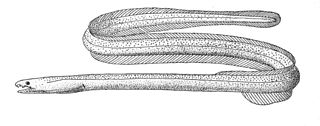
Ophichthidae is a family of fish in the order Anguilliformes, commonly known as the snake eels. The term "Ophichthidae" comes from Greek ophis ("serpent") and ichthys ("fish"). Snake eels are also burrowing eels. They are named for their physical appearance, as they have long, cylindrical, snake-like bodies. This family is found worldwide in tropical to warm temperate waters. They inhabit a wide range of habitats, from coastal shallows and even rivers, to depths below 800 m (2,600 ft). Most species are bottom dwellers, hiding in mud or sand to capture their prey of crustaceans and small fish, but some are pelagic.

The superorder Elopomorpha contains a variety of types of fishes that range from typical silvery-colored species, such as the tarpons and ladyfishes of the Elopiformes and the bonefishes of the Albuliformes, to the long and slender, smooth-bodied eels of the Anguilliformes. The one characteristic uniting this group of fishes is they all have leptocephalus larvae, which are unique to the Elopomorpha. No other fishes have this type of larvae.

Gymnothorax is a genus of fish in the family Muraenidae found in Atlantic, Indian, and Pacific Oceans. With more than 120 species, it the most speciose genus of moray eels.

Apogon is a large genus of fish in the family Apogonidae, the cardinalfishes. They are among the most common fish on coral reefs. Over 200 species have been classified in genus Apogon as members of several subgenera. Some of these subgenera, such as Ostorhinchus, have been elevated to genus status, leaving just over 50 species in the genus.

Cathorops is a genus of catfishes in the family Ariidae found in the Atlantic and Pacific Oceans. These species are found in the eastern and western Central and South America in brackish and freshwater habitats. This genus is a strongly supported clade of this family. It consists of a natural group in which the monophyly is well-defined by morphological and molecular evidence and the genus probably includes several unrecognized species from both American coasts.

Apterichtus is a genus of fish in the family Ophichthidae. Many of its species are called finless eels.

Cirrhimuraena is a genus of eels in the snake eel family Ophichthidae.
Ichthyapus is a genus of eels in the snake eel family Ophichthidae.

Muraenichthys is a genus of eels in the snake eel family Ophichthidae.
Neenchelys is a genus of snake eels native to the Indian Ocean and the western Pacific Ocean. All species of Neenchelys have two rather than three preopercular pores, a significant character among many species of ophichthids.

Ophichthus is a genus of eels in the snake eel family Ophichthidae.

Scolecenchelys is a genus of eels in the snake eel family Ophichthidae.
Yirrkala is a genus of eels in the snake eel family Ophichthidae. It is named after Yirrkala, an indigenous community in Arnhem Land, in the Northern Territory of Australia.
Anchoviella is a genus of anchovies, native to coastal parts of the tropical western Atlantic and eastern Pacific oceans, as well as rivers in South America.

Ophidion is a genus of cusk-eels.

The sooty eel is an eel in the family Ophichthidae. It was described by David Starr Jordan in 1884, originally under the genus Caecula. It is a marine, subtropical eel which is known from the western Atlantic Ocean, including North Carolina and Florida, USA, and the Gulf of Mexico. It dwells at a depth range of 0 to 27 metres. Males can reach a maximum total length of 70 centimetres (2.3 ft).
The Sooty sand-eel is an eel in the family Ophichthidae. It was described by Raymond Carroll Osburn and John Treadwell Nichols in 1916. It is a marine, tropical eel which is known from the eastern central Pacific Ocean, including Costa Rica and Mexico. It is known to dwell at a maximum depth of 20 metres (66 ft), and inhabits sand sediments. Males can reach a maximum total length of 77 centimetres (30 in).
The Round sand-eel is an eel in the family Ophichthidae. It was described by Seth Eugene Meek and Samuel Frederick Hildebrand in 1923. It reaches a maximum length of around 88 cm. It is distributed throughout the Eastern Central Pacific; inhabiting shallow, sandy bottoms.
The Longtailed sand-eel is an eel in the family Ophichthidae. It was described by Albert Günther in 1870, originally under the genus Ophichthys. It is a marine, tropical eel, which is known from Aden to Natal, South Africa, in the western Indian Ocean. Males can reach a maximum total length of 54 centimetres (21 in).
The Panama sand-eel is an eel in the family Ophichthidae. It was described by Seth Eugene Meek and Samuel Frederick Hildebrand in 1923. It is a marine, tropical eel which is known from the eastern central Pacific Ocean, including the Gulf of California, Mexico, Costa Rica, Panama, and Nicaragua. It dwells at a maximum depth of 30 metres (98 ft), and inhabits sandy sediments, sometimes in estuaries and mangroves. Males can reach a maximum total length of 76 centimetres (30 in).











